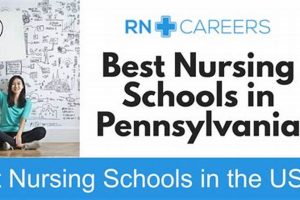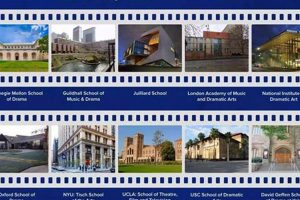Top-tier institutions specializing in visual and fine arts education offer rigorous programs, renowned faculty, and state-of-the-art facilities. These institutions often cultivate a vibrant artistic community and provide students with opportunities for exhibitions, networking, and career development. Examples of specializations include painting, sculpture, graphic design, photography, film, and animation.
Attending a highly-ranked arts college can significantly impact an aspiring artist’s trajectory. A strong educational foundation, combined with access to industry connections and prestigious resources, can pave the way for a successful career in the competitive arts world. Historically, these institutions have played a crucial role in shaping artistic movements and fostering innovation within the field. They continue to serve as incubators for creative talent, contributing significantly to the cultural landscape.
The following sections will delve into specific factors that contribute to a superior arts education, including curriculum quality, faculty expertise, available resources, and student outcomes. Further exploration will analyze prominent institutions and highlight their unique strengths and areas of specialization.
Tips for Applying to Top Art Colleges
Gaining admission to highly competitive art programs requires careful planning and a strategic approach. The following tips offer guidance for navigating the application process effectively.
Tip 1: Develop a Strong Portfolio: A compelling portfolio showcasing artistic skill and creative vision is paramount. Focus on demonstrating a cohesive body of work that reflects individual style and technical proficiency. Include diverse pieces representing a range of media and subject matter.
Tip 2: Research Program Specifics: Thorough research is essential for identifying programs aligned with individual artistic goals and preferences. Consider factors such as faculty expertise, curriculum focus, and available resources.
Tip 3: Craft Compelling Application Materials: Application essays and artist statements provide opportunities to articulate artistic motivations and aspirations. These narratives should complement the portfolio by offering deeper insights into the applicant’s creative journey.
Tip 4: Prepare for Interviews: Many top art programs conduct interviews to assess an applicant’s personality, communication skills, and artistic vision. Practice articulating ideas clearly and thoughtfully.
Tip 5: Seek Mentorship and Feedback: Guidance from experienced artists or educators can prove invaluable throughout the application process. Constructive feedback on portfolio development and application materials can significantly strengthen submissions.
Tip 6: Explore Financial Aid Options: Investigate available scholarships, grants, and financial aid packages to mitigate the costs of higher education. Many institutions offer merit-based and need-based financial assistance.
Tip 7: Meet Deadlines: Adhering to application deadlines is crucial. Organize application materials well in advance to ensure timely submission.
By following these guidelines, prospective students can enhance their chances of gaining admission to prestigious art institutions and embarking on a fulfilling artistic journey.
In conclusion, a strategic and well-informed approach to the application process is essential for achieving success in this competitive field.
1. Faculty Expertise
Faculty expertise stands as a cornerstone of highly ranked art institutions. Accomplished artists and scholars contribute significantly to the educational landscape, providing students with unparalleled learning opportunities. Experienced faculty members bring a wealth of practical knowledge, critical insights, and professional connections to the classroom. Their influence shapes curriculum development, mentorship programs, and overall institutional prestige. For instance, the presence of renowned sculptors on faculty elevates a sculpture program’s standing, attracting talented students and fostering a vibrant artistic community. Similarly, institutions with faculty actively engaged in the contemporary art world provide students with valuable exposure to current trends and professional networks.
The impact of faculty expertise extends beyond technical skill development. Mentorship plays a crucial role in nurturing artistic growth and fostering individual creative expression. Established artists guiding emerging talent provide invaluable feedback, critical analysis, and career advice. This personalized attention cultivates a supportive learning environment where students can refine their artistic vision and develop professional skills. Furthermore, faculty research and creative practice contribute to the institution’s intellectual and artistic vitality. Active scholarship and exhibition records enhance an institution’s reputation and attract funding opportunities, further enriching the student experience.
Institutions seeking to cultivate excellence prioritize recruiting and retaining exceptional faculty. Investing in faculty development, providing resources for research and creative practice, and fostering a supportive academic environment are essential for attracting and retaining leading artists and scholars. The strength of an art college’s faculty directly correlates with its ability to provide a high-quality education and prepare students for successful careers in the arts. The presence of accomplished professionals not only enhances the learning experience but also contributes to the institution’s overall reputation and standing within the broader art world. This, in turn, attracts prospective students and fosters a dynamic artistic community.
2. Curriculum Rigor
Curriculum rigor serves as a defining characteristic of top art colleges, shaping student development and influencing institutional standing. A demanding curriculum fosters critical thinking, technical proficiency, and artistic exploration, preparing graduates for the challenges and opportunities of a professional art career. The following facets highlight key components of a rigorous art curriculum:
- Foundation Studies:
A solid foundation in art fundamentals is essential for artistic growth. Rigorous foundation programs emphasize drawing, painting, sculpture, and art history, providing students with a comprehensive understanding of core principles and historical context. For example, intensive drawing courses cultivate observational skills and anatomical understanding, while art history surveys provide a framework for analyzing and interpreting artistic movements. These foundational skills serve as building blocks for advanced study and professional practice.
- Conceptual Development:
Emphasis on conceptual development cultivates critical thinking and artistic innovation. Coursework challenges students to explore complex ideas, develop unique artistic voices, and engage with contemporary issues. Critique sessions, workshops, and collaborative projects foster intellectual exchange and encourage experimentation. The ability to articulate artistic concepts and engage in critical discourse is essential for professional success.
- Technical Proficiency:
Mastery of technical skills is crucial for realizing artistic visions. Rigorous programs provide intensive training in a variety of media and techniques, equipping students with the tools necessary to execute their creative ideas effectively. Specialized workshops in printmaking, ceramics, or digital media, for example, allow students to explore diverse artistic processes and develop advanced technical skills. This proficiency empowers students to translate their concepts into tangible works of art.
- Professional Practice:
Preparation for professional practice bridges the gap between academic study and the art world. Coursework addressing portfolio development, grant writing, marketing, and legal issues equips students with the practical skills necessary to navigate the professional landscape. Internship opportunities and collaborations with galleries or museums provide real-world experience and valuable industry connections. This focus on professional practice ensures that graduates are well-prepared to launch successful art careers.
These interconnected components contribute to a comprehensive and demanding art education. Institutions prioritizing curriculum rigor cultivate a challenging yet supportive learning environment that fosters artistic excellence and prepares graduates for the demands of the professional art world. Graduates of such programs emerge not only with strong technical skills and conceptual depth but also with the professional acumen necessary to thrive in a competitive creative landscape. This combination of artistic proficiency and practical knowledge distinguishes graduates of top art programs and contributes to their long-term success.
3. Resource Availability
Resource availability significantly distinguishes leading art institutions from their counterparts. Access to state-of-the-art facilities, equipment, and specialized collections directly impacts the quality of artistic training and the breadth of creative exploration possible. These resources serve as essential tools for skill development, experimentation, and professional portfolio creation. Institutions investing in comprehensive resource provision demonstrate a commitment to fostering artistic excellence and preparing graduates for the demands of the professional art world.
- Studio Spaces:
Well-equipped studio spaces are fundamental to artistic practice. Dedicated studios for painting, sculpture, printmaking, ceramics, and other disciplines provide students with ample space and specialized equipment to develop their craft. Access to well-ventilated painting studios with natural light, for example, or spacious sculpture studios with welding equipment and kilns, is essential for realizing ambitious artistic projects. The availability of these specialized spaces directly correlates with the quality and scope of student work.
- Technology and Equipment:
Access to cutting-edge technology and equipment is increasingly vital in contemporary art practice. Digital fabrication labs, darkrooms, sound recording studios, and video editing suites equip students with the tools necessary to explore diverse media and engage with emerging technologies. Institutions providing access to industry-standard software, 3D printers, laser cutters, or high-end cameras empower students to push creative boundaries and develop skills relevant to the evolving art market. This access to advanced technology distinguishes leading art programs and prepares graduates for the technological demands of the professional art world.
- Library and Archival Resources:
Extensive library and archival collections provide essential resources for art historical research, critical analysis, and artistic inspiration. Access to rare books, archival documents, and specialized art journals enriches students’ understanding of art history, theory, and criticism. Robust digital databases and online resources further expand research capabilities and provide access to a wealth of scholarly material. These resources support both academic study and artistic practice, fostering intellectual curiosity and informing creative development.
- Galleries and Exhibition Spaces:
Dedicated gallery spaces and opportunities for exhibitions provide students with invaluable experience in presenting their work to a wider audience. On-campus galleries, student-run exhibition spaces, and partnerships with local museums or galleries offer platforms for showcasing artistic achievements and engaging with the broader art community. These opportunities cultivate professional skills in exhibition planning, installation, and public presentation, preparing students for the realities of exhibiting and promoting their work in the professional art world. The availability of exhibition opportunities contributes significantly to the overall student experience and enhances an institution’s visibility within the art world.
The convergence of these resources cultivates a rich and dynamic learning environment. Institutions prioritizing resource provision empower students to explore their creative potential fully, develop professional skills, and build strong portfolios. This commitment to providing comprehensive resources distinguishes the best art colleges and contributes significantly to their graduates’ success in the competitive art world. By investing in these essential tools and spaces, institutions foster artistic innovation and prepare graduates to make meaningful contributions to the field.
4. Alumni Network
A robust alumni network represents a significant advantage for both graduates and the institutions they attended. For graduates of top art colleges, a strong alumni network offers invaluable career support, mentorship opportunities, and access to a community of established professionals. This network facilitates connections with potential employers, collaborators, and mentors, significantly enhancing career prospects and providing a crucial support system within the competitive art world. For institutions, a successful and engaged alumni network strengthens reputation and attracts prospective students. The achievements of alumni reflect the quality of education and training provided, enhancing the institution’s prestige and contributing to its overall success.
The influence of a strong alumni network can be observed in various ways. Graduates often find employment through connections made within the alumni community. Mentorship programs pairing established alumni with recent graduates provide invaluable guidance and support during the crucial early stages of a career. Alumni networks also foster a sense of community and shared experience, creating opportunities for collaboration and mutual support. Real-world examples demonstrate the practical significance of these connections. A graphic design graduate might find employment at a leading design firm through a connection made with an alumnus working at the company. A young painter might receive mentorship from a successful alumnus, gaining valuable insights into the art market and professional practice. These connections demonstrate the tangible benefits of a strong alumni network, both for individual graduates and the broader artistic community.
Cultivating a thriving alumni network requires ongoing effort and investment from both institutions and alumni. Institutions can foster alumni engagement through events, networking opportunities, and online platforms. Alumni associations play a crucial role in connecting graduates and providing resources for career development and professional networking. Active participation from alumni in mentorship programs, career fairs, and institutional events strengthens the network and contributes to its overall effectiveness. The strength of an alumni network reflects the vitality of the institution and its commitment to supporting its graduates throughout their careers. A thriving network serves as a testament to the institution’s educational excellence and its enduring impact on the art world.
5. Location Influence
Geographic location significantly influences the character and opportunities associated with art colleges. Proximity to major art markets, museums, galleries, and a vibrant cultural scene provides students with unparalleled access to professional networks, internships, and exposure to diverse artistic practices. Cities like New York, Los Angeles, and Chicago, recognized as major art hubs, offer a dynamic environment that fosters creative exchange and career development. Conversely, institutions situated in smaller cities or rural settings may offer a more focused learning environment, emphasizing specific disciplines or artistic traditions. The location shapes the educational experience and influences post-graduate trajectories.
Location influences an institution’s curriculum and faculty. Art colleges situated near renowned museums often integrate these resources into their curriculum, offering students direct access to significant collections and exhibitions. Faculty members are often active participants in the local art scene, providing students with valuable connections and insights into the professional art world. For instance, a college located near a prominent design district might offer specialized courses in user experience design, reflecting the local industry’s focus. Similarly, an institution situated in a region known for its craft traditions might emphasize ceramics or textile arts within its curriculum. These examples demonstrate the interconnectedness of location and educational offerings.
Choosing an art college requires careful consideration of location-specific advantages and disadvantages. Urban centers offer access to a wider range of professional opportunities and cultural experiences but often come with higher living costs. Smaller cities or rural settings may provide a more affordable cost of living and a close-knit artistic community but may offer fewer internship or employment opportunities. Ultimately, the optimal location depends on individual priorities, artistic goals, and preferred learning environment. Understanding the influence of location allows prospective students to make informed decisions aligned with their long-term aspirations. Careful evaluation of these factors is crucial for selecting an institution that offers the optimal environment for artistic growth and professional development.
Frequently Asked Questions
This section addresses common inquiries regarding highly ranked visual and fine arts institutions in the United States. The information provided aims to clarify application procedures, program specifics, and general concerns.
Question 1: What role does the portfolio play in the admissions process?
The portfolio serves as the most critical component of art college applications. It showcases artistic skills, creative potential, and individual style. A compelling portfolio should present a cohesive body of work demonstrating technical proficiency, conceptual depth, and a unique artistic vision.
Question 2: How important are standardized test scores for art college applications?
While academic performance is considered, standardized test scores often hold less weight in art college admissions compared to other academic disciplines. The primary focus remains on the portfolio and the applicant’s demonstrated artistic abilities. However, strong academic records can demonstrate a commitment to learning and a capacity for rigorous study.
Question 3: What types of financial aid are available for art students?
A range of financial aid options, including scholarships, grants, and loans, are available to art students. Many institutions offer merit-based scholarships based on artistic talent and academic achievement. Need-based aid is also available to eligible students. Researching specific institutional financial aid policies is advised.
Question 4: How does one choose the right art program?
Selecting a suitable art program requires careful consideration of factors such as program focus, faculty expertise, available resources, and location. Aligning personal artistic goals with institutional strengths is essential. Thorough research, including reviewing program websites and attending virtual information sessions, can inform decision-making. Visiting campuses and speaking with current students can offer valuable insights into the programs culture and learning environment.
Question 5: What career paths are common for art school graduates?
Art school graduates pursue diverse career paths, including studio art, graphic design, illustration, animation, photography, art education, art therapy, and arts administration. The chosen program of study and individual career aspirations influence post-graduate trajectories. Career services offices within art institutions provide guidance and resources for job placement and career development.
Question 6: How can prospective students prepare for the art college application process?
Early preparation is crucial for a successful application process. Developing a strong portfolio, researching programs, and seeking mentorship from art educators are recommended. Attending portfolio review days and visiting campuses can offer valuable feedback and insights. Careful planning and organization are essential for navigating the application process effectively.
Thorough research and thoughtful planning are essential for navigating the art college application process successfully and securing a place in a program aligned with individual artistic goals and aspirations.
The subsequent section will delve into specific examples of top art colleges in the United States, offering detailed profiles of their programs, faculty, and resources.
Conclusion
Selecting among the best art colleges in the US represents a pivotal decision for aspiring artists. This exploration has highlighted the multifaceted nature of evaluating top institutions, emphasizing the significance of faculty expertise, curriculum rigor, resource availability, alumni networks, and geographic location. Each element contributes uniquely to the educational experience and influences post-graduate outcomes. Understanding these interconnected factors empowers prospective students to make informed choices aligned with individual artistic goals and career aspirations.
The pursuit of artistic excellence demands dedication, rigorous training, and a supportive environment. Top art colleges provide a fertile ground for creative growth, fostering innovation and preparing graduates for the challenges and rewards of a professional art career. The future of the art world rests upon the shoulders of emerging artists nurtured within these institutions. Careful consideration of the factors presented herein will contribute significantly to selecting the optimal environment for artistic development and future success within the dynamic and ever-evolving landscape of the arts.







